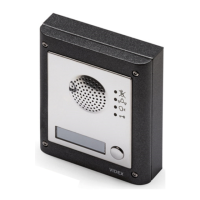66250756-EN - V2.1 - 05/11/19
- 33 -
4000 Series GSM Lite Audio Intercom - Technical Manual
4000 Series GSM Lite Audio Intercom
Programming the GSM Intercom
DELETE A DIAL TO OPEN NUMBER WITHOUT KNOWING IT’S LOCATION DET
Although a dial to open number (DTO) can be deleted from the GSM LITE using the programming command 1111STRnnn””? , it
is also possible to delete a dial to open number if the location is not known. The following messages can be used to delete and
conrm a dial to open number has been deleted from the GSM LITE.
1111DET”yyyyyyyyyyy” Delete the dial to open number yyyyyyyyyyy (where yyyyyyyyyyy DTO number).
1111DET”yyyyyyyyyyy”? Delete the dial to open number yyyyyyyyyyy (where yyyyyyyyyyy DTO number). Also
send a conrmation text back to the sender.
Note that when using this command the full telephone number will be required otherwise the GSM LITE will respond with:
NOT FOUND
OK VIDEX GSM
SET CALL TIME SPT
The call time is the maximum time in seconds that a call will last before the GSM LITE intercom automatically clears the call down.
The time can be set from 20 seconds up to 240 seconds (4 minutes) and begins from when the call button is rst pressed. The default
time is set to 40 seconds. The following messages can be used to set/check the maximum call time.
1111SPTnn Store the time nn x 20 seconds (e.g. nn = 03, time = 60 seconds).
1111SPTnn? Store the time nn x 20 seconds (e.g. nn = 02, time = 40 seconds, refer to table below), also
send a conrmation text back to the sender.
1111SPT? Query the current stored time. A text message will be sent back to the sender showing the
stored time (remember to multiply the number in the received text by 20 seconds).
nn multiplier: nn = 01, time = 20 secs nn = 02, time = 40 secs nn = 03, time = 60 secs
nn = 04, time = 80 secs nn = 05, time = 100 secs nn = 06, time = 120 secs
nn = 07, time = 140 secs nn = 08, time = 160 secs nn = 09, time = 180 secs
nn = 10, time = 200 secs nn = 11, time = 220 secs nn = 12, time = 240 secs
SET RELAY TIME RLT
The relay time can be from 01 – 99 seconds or latching (set the relay time to 00 for latched mode. In latch mode, the relay will stay
energised until the command is sent again).
1111RLTnn Store the relay time nn = time in seconds (e.g. nn = 05, time = 5 seconds).
1111RLTnn? Store the relay time nn = time in seconds. Also send a conrmation text back to the sender.
1111RLT? Query the current stored relay time. A text message will be sent back to the sender
showing the stored relay time.
SET AUXILIARY OUTPUT AO1 TIME A1T, FOR A1M = 01 ONLY
The auxiliary output AO1 time can be set from 01 - 99 seconds or latching (set the AO1 output time to 00 for latched mode. In latch
mode the AO1 output will stay triggered until the relevant command is sent again to unlatch the AO1 output. This option is only
available when the AO1 output mode, A1M, is set to mode 01. Please refer to the A1M commands below for more details).
1111A1Tnn Store the AO1 time nn = time in seconds (e.g. nn = 05, time = 5 seconds).
1111A1Tnn? Store the AO1 time nn = time in seconds. Also send a conrmation text back to the sender.
1111A1T? Query the current stored AO1 time. A text message will be sent back to the sender showing
the stored AO1 time.
SET AUXILIARY OUTPUT AO1 MODE A1M, MODES 00 05
The auxiliary output AO1 has up to six modes that can be set:
Call Activated: nn = 00
AO1 output will activate when a call begins and deactivate when a call ends. See example, Fig.16, on page 18.
User Activated: nn = 01
To activate the AO1 output either short terminals g to 5 (auxiliary 1 input) on the GSM LITE intercom or press 6 on the telephone
during a call. See example, Fig.17, on page 18.
Used for Status Indication: nn = 02
When in this mode, the AO1 terminal is used exclusively for monitoring the status of an input. For example, checking if a gate/door
is open or closed. See example, Fig.18, on page 19.

